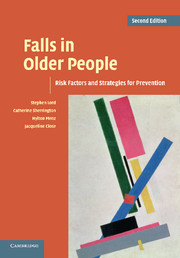Book contents
- Frontmatter
- Contents
- Preface
- Acknowledgements
- Part I Epidemiology and risk factors for falls
- Part II Strategies for prevention
- 10 Exercise interventions to prevent falls
- 11 Exercise interventions to improve physical functioning
- 12 Medical management of older people at risk of falls
- 13 Assistive devices and falls prevention
- 14 Modifying the environment to prevent falls
- 15 Prevention of falls in hospitals and residential aged care facilities
- 16 A physiological profile approach to falls risk assessment and prevention
- 17 Research into practice
- Part III Research issues in falls prevention
- Index
- References
13 - Assistive devices and falls prevention
Published online by Cambridge University Press: 03 May 2010
- Frontmatter
- Contents
- Preface
- Acknowledgements
- Part I Epidemiology and risk factors for falls
- Part II Strategies for prevention
- 10 Exercise interventions to prevent falls
- 11 Exercise interventions to improve physical functioning
- 12 Medical management of older people at risk of falls
- 13 Assistive devices and falls prevention
- 14 Modifying the environment to prevent falls
- 15 Prevention of falls in hospitals and residential aged care facilities
- 16 A physiological profile approach to falls risk assessment and prevention
- 17 Research into practice
- Part III Research issues in falls prevention
- Index
- References
Summary
As discussed in Chapter 1, falls result from the interaction between intrinsic risk factors (i.e. those pertaining to the individual, such as poor vision and reduced strength) and extrinsic risk factors (i.e. those relating to environmental hazards). The interface between the individual and their environment is also important, and can be modified by a range of physical assistive devices, which are used by at least one-quarter of older people. Devices to be addressed in this chapter include footwear, foot orthoses, walking aids, other physical assistive devices, spectacles, hip protectors, aids to prevent ‘long lies’ and restraints. The potential impact of each of these devices on falls and/or fall injury is discussed.
Footwear
Footwear has an important role in protecting the foot from extremes of temperature, moisture and mechanical trauma. However, since the development and widespread popularity of fashion footwear in the 1600s, the functional aspect of footwear has largely been supplanted by cosmetic requirements. In both males and females of all ages, shoe selection is primarily based on aesthetic considerations, many of which are incompatible with optimal function of the lower extremity. This is of particular importance in older people, as certain types of footwear, by modifying the interface between the sole of the foot and the ground, may have a significantly detrimental impact on postural stability and possibly predispose to falls.
Unfortunately, evidence to support the suggestion that certain types of shoes increase the risk of falls is meagre.
- Type
- Chapter
- Information
- Falls in Older PeopleRisk Factors and Strategies for Prevention, pp. 264 - 299Publisher: Cambridge University PressPrint publication year: 2007

